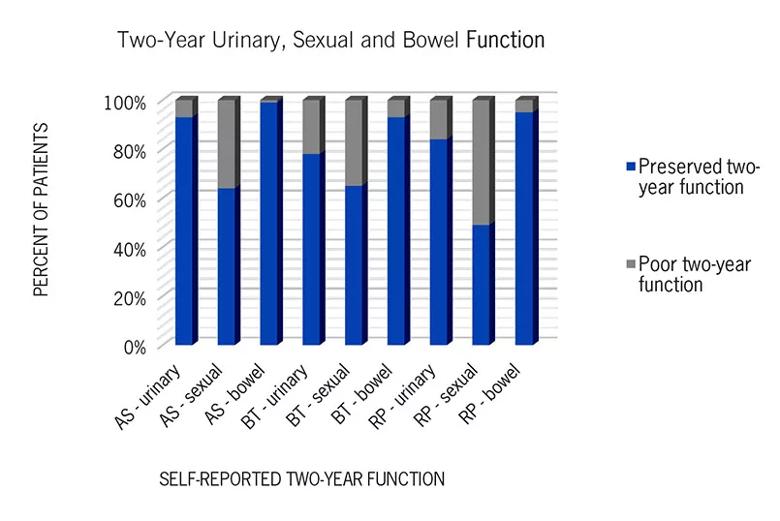Advertisement
Helping urologists and patients make shared treatment decisions

By Shree Agrawal, BS; Eric Klein, MD; and Andrew Stephenson, MD
Advertisement
Cleveland Clinic is a non-profit academic medical center. Advertising on our site helps support our mission. We do not endorse non-Cleveland Clinic products or services. Policy
With advances in prostate cancer therapy, achieving a disease-free state is an important and often tangible goal for patients. However, men may still experience genitourinary and bowel side effects from current management options. Urinary, bowel and sexual function are commonly affected by definitive surgical and/or radiation therapies, which may have a meaningful impact on quality of life.
In choosing among today’s definitive therapeutic options, men diagnosed with prostate cancer can elect surgery, radiation and active surveillance protocols. The shared decision between urologists and patients weighs optimal urinary, bowel and sexual function as goals of care, in addition to disease-free survival (DFS).
We undertook a large institutional review to understand current rates of urinary, bowel and sexual function in an effort to define parameters that could help urologists inform and guide patients facing this decision.
Our study assessed both patient and disease characteristics, and subsequent management protocols for association with urinary, bowel and sexual function at two years following management decision. Patients opting for radical prostatectomy (RP), brachytherapy (BT) or active surveillance (AS) were included in the study. We presented our findings at the American Urological Association’s 2017 annual meeting,
The study included 572 patients who underwent definitive procedural treatment or AS at the Cleveland Clinic. Patients completed a validated Prostate Health Related Quality of Life Questionnaire at both the time of treatment selection and at two-year follow-up. Urinary, bowel and sexual function at two years were assessed by self-reported responses to quantify how much each parameter was a bother in their life.
Advertisement
Patient and disease characteristics, baseline urinary, sexual and bowel function, and management selection were analyzed on multivariable logistic regression models for two-year function outcomes. The median age in this cohort was 62 years (IQR: 57-68) with 109 (19 percent) patients electing BT, 102 (18 percent) participating in AS, and 361 (63 percent) undergoing RP.
Among our findings regarding sexual function:
Our findings around bowel function included:
On multivariable logistic regression for urine function at two years, we found:
Two-year urinary, sexual and bowel function assessments among patients managed for localized prostate cancer are based on multiple patient characteristics in addition to the shared decision to undergo BT, RP or AS. Additional studies are required to examine matched functional outcomes among men managed for localized prostate cancer.
We found RP and BT, when compared to AS, increased odds of worsening urinary and sexual function, associations which have been reported previously in the literature. However, neither surgical or radiation interventions were associated with worse bowel function. This study highlights presence of a partner to be associated with better preservation of sexual function. It also underscores that patients who have poor baseline bowel function have greater odds of worse bowel function post-treatment, regardless of treatment decision for prostate cancer. The presence of a partner in a patient’s life and baseline bowel function may be important factors when weighing sexual and bowel outcomes within two years with prostate cancer management strategies.
Advertisement
For patients with low- to intermediate-risk prostate cancer who are good candidates for active surveillance, choosing this approach over immediate intervention may preserve urinary and sexual function for a longer period of time.
This study serves to highlight additional factors to include in the shared decision between clinician and patient when choosing between BT, RP and AS for optimal therapeutic and functional outcomes.

This chart illustrates the rates of self-reported poor and preserved urinary, sexual and bowel function two years following patient-centered treatment decision making. Treatment, patient and disease characteristics associated with these rates were assessed by multivariable logistic regression analysis.
Shree Agrawal, BS, is a clinical research fellow at Cleveland Clinic Glickman Urological & Kidney Institute and a Case Western Reserve University medical student. Dr. Klein is Chair and Dr. Stephenson is on staff at the institute. Anna Zampini, MD; Bradley Gill, MD; Sudhir Isharwal, MD; Joseph Zabell, MD; Yaw Nyame, MD; and JJ Haijing Zhang, MD, also contributed to this research.
Advertisement
Advertisement

Collaborative research effort underscores the urgent need for effective second-line therapies in this rare, aggressive cancer

Largest study to date comparing direct-acting oral anticoagulants to low-molecular-weight heparin

Treatment assigned FDA review date in June 2025

Pembrolizumab does not improve outcomes, but immunotherapy may still offer benefit

Cleveland Clinic, the University of Minnesota and University of Cambridge receive $1M grant to develop point-of-care biosensor for early detection and treatment personalization

Long-acting antiemetics and high-dose steroids key to minimizing acute nausea

Neoadjuvant immunotherapy improves outcomes

Use of GLP-1s and improving cardiovascular health lowers risk of hematologic malignancies